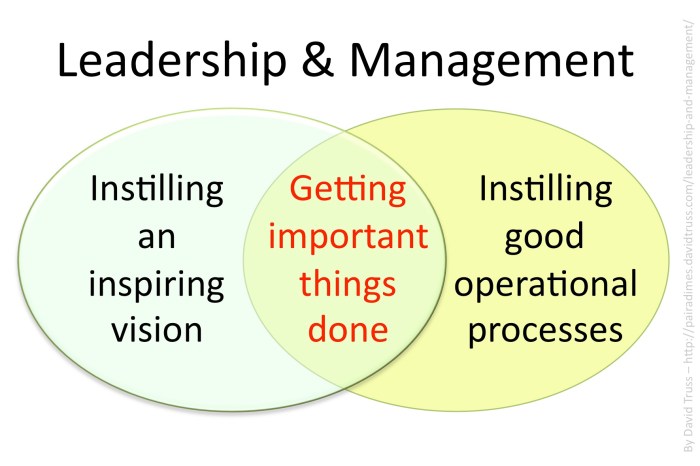
Leadership Development is not just a buzzword—it’s a vital process that shapes the future of organizations across various sectors. From telecommunications to textiles, effective leadership drives teams and fosters innovation. In this exploration, we’ll dive into the key traits that define great leaders and the role emotional intelligence plays in nurturing these traits.
We’ll also explore various methods and training programs that have proven successful, along with real-world case studies that highlight the impact of strong leadership in industries like publishing and printing. By the end, you’ll see how effective leadership not only boosts employee engagement but also enhances productivity across different fields.
Leadership Development Concepts
Leadership development is a crucial aspect of organizational success, as it fosters the skills and capabilities necessary for effective guidance. Effective leaders inspire and motivate their teams, drive innovation, and navigate complex challenges. Understanding the fundamental concepts behind leadership development can significantly impact various industries, including telecommunications and textiles, where leadership plays a pivotal role in driving growth and fostering a positive workplace culture.
Essential Traits of Effective Leadership
To cultivate effective leaders, it’s important to recognize the essential traits that define them. These traits create a framework for leadership development programs and help individuals understand the qualities they should strive to embody. Key traits include:
- Communication Skills: Effective leaders are excellent communicators, capable of conveying their vision and expectations clearly to their team members.
- Integrity: Trustworthiness and honesty are foundational traits that inspire confidence and loyalty within a team.
- Empathy: Understanding and relating to the feelings of others fosters a supportive environment and strengthens team cohesion.
- Adaptability: The ability to adjust to changing situations and embrace new challenges is vital for sustained leadership success.
- Decisiveness: Making informed decisions promptly is critical, particularly in high-pressure environments.
Importance of Leadership Development in Various Industries
Leadership development is particularly significant in industries such as telecommunications and textiles, where rapid changes and competition demand strong leadership capabilities. In telecommunications, for instance, the rapid evolution of technology requires leaders who can foster innovation and guide their teams through transformation. Similarly, in textiles, where sustainability and responsive supply chains are increasingly crucial, leaders must be equipped to handle both operational and strategic challenges effectively.
- Telecommunications: Leadership development ensures that managers can navigate technological shifts and inspire their teams to embrace new methods and tools.
- Textiles: Training in leadership helps professionals address environmental challenges, promoting sustainable practices while ensuring productivity.
Role of Emotional Intelligence in Leadership Development
Emotional intelligence (EI) is a vital component of leadership development, as it directly influences how leaders manage their emotions and understand those of others. High EI enables leaders to create an inclusive and motivating environment, enhancing team dynamics and overall performance. The key components of emotional intelligence include:
- Self-Awareness: Understanding one’s emotions and their impact on decision-making leads to more thoughtful leadership.
- Self-Regulation: The ability to control impulses and respond constructively to challenges is essential for maintaining a positive team atmosphere.
- Motivation: Emotionally intelligent leaders are driven by intrinsic motivation, which can inspire their teams to pursue excellence.
- Social Skills: Strong interpersonal skills facilitate collaboration and conflict resolution, essential for team success.
- Empathy: Recognizing and validating the emotions of others strengthens relationships and fosters a supportive workplace culture.
“Emotional intelligence is not just about understanding one’s feelings; it’s about using that understanding to lead and inspire others.”
Methods and Approaches to Leadership Development

Leadership development is an essential aspect of organizational growth and individual career advancement. Various methods and approaches have been created to cultivate effective leaders who can inspire and guide teams towards achieving their goals. This section explores different training programs available, successful case studies in specific sectors, and a comparison of traditional and contemporary techniques in leadership development.
Training Programs for Leadership Development
Organizations employ a variety of training programs tailored to different leadership needs. These programs can focus on individual skills, team dynamics, or organizational culture. Here are some commonly utilized training programs:
- Executive Coaching: Personalized coaching sessions aimed at enhancing the leadership capabilities of senior executives. This program often includes feedback mechanisms and action plans to develop specific leadership skills.
- Workshops and Seminars: Short, intensive sessions that cover specific topics such as conflict resolution, strategic thinking, and team-building exercises. These can be in-person or virtual and are often interactive to engage participants fully.
- Mentorship Programs: Pairing emerging leaders with seasoned professionals to provide guidance, share knowledge, and foster professional relationships. This encourages learning through experience and observation.
- Leadership Development Programs (LDPs): Comprehensive, structured programs that may span several months and include assessments, workshops, and practical projects designed to build leadership competencies over time.
- Online Learning Platforms: Flexible, self-paced online courses that offer a wide range of topics relevant to leadership development. These programs are accessible and allow participants to learn at their convenience.
Successful Case Studies in the Publishing and Printing Sector
The publishing and printing industry has seen notable success through effective leadership development initiatives. Organizations have implemented tailored programs that yield measurable improvements in operational efficiency and employee engagement. A few examples include:
- Random House: Implemented a leadership training program focused on creative leadership and innovation. Participants reported an increase in collaborative projects, resulting in successful book releases that defied market trends.
- Deluxe Corporation: Launched an executive coaching initiative that resulted in a 30% increase in employee retention rates. Leaders developed better communication skills, which fostered a more inclusive workplace environment.
- Penguin Group: Introduced a mentorship program that paired young leaders with experienced executives, leading to a significant rise in internal promotions and a boost in overall employee morale.
Comparison of Traditional and Contemporary Leadership Development Techniques
Understanding the difference between traditional and contemporary leadership development techniques is critical for organizations to adapt to changing environments. Traditional methods often focus on hierarchical models and structured programs, whereas contemporary approaches emphasize flexibility and innovation. Below is a comparison highlighting key differences:
| Aspect | Traditional Techniques | Contemporary Techniques |
|---|---|---|
| Focus | Top-down authority and command | Collaborative and inclusive leadership styles |
| Delivery | Formal training sessions and lectures | Interactive learning experiences, including simulations and role-playing |
| Assessment | Standardized tests and evaluations | 360-degree feedback and peer reviews |
| Learning Environment | Structured, classroom setting | Flexible, digital platforms, and real-world scenarios |
| Outcome Measurement | Focus on knowledge acquisition | Emphasis on skill application and behavioral change |
“Effective leadership development is not just about acquiring knowledge; it’s about transforming that knowledge into actionable skills and behaviors.”
Impact of Leadership on Employment and Work

Effective leadership plays a pivotal role in shaping the dynamics of employment and work environments. Leaders not only influence the strategic direction of organizations but also directly affect employee morale, engagement, and retention. When leadership is strong, it creates a fertile ground for innovation, collaboration, and productivity, which are essential for both organizational growth and employee satisfaction.
Influence of Leadership on Employee Engagement and Retention Rates
The relationship between effective leadership and employee engagement is significant. Engaged employees are more invested in their work and aligned with the organization’s goals, which ultimately leads to higher retention rates. A study by Gallup found that companies with engaged employees have 21% higher profitability. To illustrate the impact of leadership on engagement, consider these factors:
- Communication: Open lines of communication foster trust and transparency, making employees feel valued and heard.
- Recognition: Acknowledging employee achievements boosts morale and encourages continued effort, enhancing loyalty to the organization.
- Development Opportunities: Leaders who invest in employee development create a culture of growth, which increases retention as employees see a future within the organization.
Correlation Between Strong Leadership and Productivity
Productivity levels in both domestic services and industrial goods sectors are significantly enhanced by strong leadership. Leaders set the vision and tone for performance, driving teams toward common objectives. Successful organizations often exhibit a direct correlation between effective leadership practices and high productivity metrics.For example, in the manufacturing sector, companies like Toyota have demonstrated that strong leadership fosters a culture of continuous improvement, known as “Kaizen,” which leads to increased productivity and reduced waste.
This approach has resulted in:
- Improved operational efficiency through streamlined processes.
- Enhanced employee empowerment, allowing workers to contribute suggestions for productivity improvements.
- Cultural shifts that prioritize teamwork and collaboration.
Framework for Evaluating Leadership Effectiveness in Workplace Innovation
Evaluating leadership effectiveness in fostering innovation requires a structured approach. A proposed framework includes the following components to assess how leadership impacts workplace innovation:
1. Innovation Culture Assessment
Measure the extent to which leaders promote a culture that encourages creativity and experimentation.
2. Leadership Style Evaluation
Analyze the leadership styles in place (transformational, transactional, etc.) and their effectiveness in inspiring innovation.
3. Employee Feedback Mechanisms
Implement regular surveys and feedback loops to gather insights on how leadership is perceived concerning innovation.
4. Innovation Outcomes Measurement
Track metrics such as the number of new ideas generated, implemented, and the overall impact on business growth.This framework not only helps in identifying areas for improvement but also ensures that innovation is a core focus within business development strategies.
Concluding Remarks
In conclusion, Leadership Development is an essential investment for any organization looking to thrive in a competitive landscape. The journey through training programs, emotional intelligence, and real-world examples illustrates its profound impact on engagement and productivity. By fostering strong leaders, organizations can create innovative workplaces that are equipped to handle the challenges of tomorrow.
Essential Questionnaire
What is Leadership Development?
Leadership Development refers to the process of enhancing the skills, knowledge, and abilities of individuals to lead effectively within an organization.
Why is emotional intelligence important in leadership?
Emotional intelligence helps leaders understand and manage their own emotions while empathizing with others, which is crucial for effective team dynamics and communication.
What are common methods used in Leadership Development?
Common methods include mentorship programs, training workshops, coaching, and experiential learning opportunities.
How can I measure the effectiveness of Leadership Development?
Effectiveness can be measured through employee engagement scores, retention rates, and overall productivity improvements in teams led by developed leaders.
Is Leadership Development only for upper management?
No, Leadership Development is beneficial at all levels of an organization as it promotes a culture of leadership and accountability.





